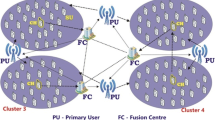Abstract
Cooperation among unlicensed secondary users was more significant in cognitive radio ad hoc networks (CRAHNs). The main challenges of CRAHNs now a day address the main issues of spectrum scarcity and underutilization. Due to the lack of channel sensing, cooperative spectrum sensing (CSS) is the main challenge in CRAHNs. Efficient CSS is more essential to enhance the detection of performance by utilizing the theoretical studies of spatially distributed secondary users (SUs). This paper uses the priority-based two-stage detection model (PBTSDM) to analyze the cooperation strategy among secondary users (SUs) and primary users (PUs). SUs in distributed CSS sense continuously amongst themselves and take unified decision on the presence or absence of PUs by using entropy-based energy detection mechanism. The simulation results reveal that the sensing accuracy in terms of sensing time and energy efficiency (in terms of minimum energy consumption) increased significantly by using the proposed scheme.









Similar content being viewed by others
References
Singh, J. S. P., Singh, J., & Kang, A. S. (2013). Cognitive radio: State of research domain in next generation wireless networks—a critical analysis. International Journal of Computer Applications, 74(10), 1–9.
Zhao, N. (2013). A novel two-stage entropy-based robust cooperative spectrum sensing scheme with two-bit decision in cognitive radio. Wireless Personal Communications, 69(4), 1551–1565. doi:10.1007/s11277-012-0650-2.
Zhao, N., Yu, F. R., Sun, H., & Nallanathan, A. (2013). Energy-efficient cooperative spectrum sensing schemes for cognitive radio networks. EURASIP Journal on Wireless Communications and Networking. doi:10.1186/1687-1499-2013-120.
Chen, X., & Nagaraj, S. (2008). Entropy based spectrum sensing in cognitive radio. In Wireless Telecommunications Symposium, WTS 2008, Pomona, CA (pp. 57–61). doi:10.1109/WTS.2008.4547544.
Zhang, Y. L., Zhang, Q. Y., & Melodia, T. (2010). A frequency-domain entropy-based detector for robust spectrum sensing in cognitive radio networks. IEEE Communications Letters, 14(6), 533–535. doi:10.1109/LCOMM.2010.06.091954.
Cacciapuoti, A. S., Akyildiz, I. F., & Paura, L. (2012). Correlation-aware user selection for cooperative spectrum sensing in cognitive radio ad hoc networks. IEEE Journal on Selected Areas in Communications, 30(2), 297–307. doi:10.1109/JSAC.2012.120208.
Zhao, Y., Li, S., Zhao, N., & Wu, Z. (2010). A novel energy detection algorithm for spectrum sensing in cognitive radio. Information Technology Journal, 9(8), 1659–1664. doi:10.3923/itj.2010.1659.1664.
Cacciapuoti, A. S., Caleffi, M., & Paura, L. (2012). Reactive routing for mobile cognitive radio ad hoc networks. Ad Hoc Networks, 10, 803–815. doi:10.1016/j.adhoc.2011.04.004.
Ma, J., Zhao, G., & Li, Y. (2008). soft combination and detection for cooperative spectrum sensing in cognitive radio networks. IEEE Transactions on Wireless Communications, 7(11), 4502–4507. doi:10.1109/T-WC.2008.070941.
Mustonen, M., Matinmikko, M., & Mammela, A. (2009). Cooperative spectrum sensing using quantized soft decision combining. In 2009 4th International Conference on Cognitive Radio Oriented Wireless Networks and Communications, Hannover (pp. 1–5). doi:10.1109/CROWNCOM.2009.5188980.
Xia, H., Zhang, G., & Xu, H. (2011). A flexible cooperative spectrum sensing scheme for cognitive radio networks. IEICE Electronics Express, 8(8), 542–548. doi:10.1587/elex.8.542.
Fazeli-Dehkordy, S., Plataniotis, K. N., & Pasupathy, S. (2010). Two-stage spectrum detection in cognitive radio networks. In 2010 IEEE International Conference on Acoustics, Speech and Signal Processing, Dallas, TX (pp. 3118–3121). doi:10.1109/ICASSP.2010.5496090.
Li, G. Y., et al. (2011). Energy-efficient wireless communications: tutorial, survey, and open issues. IEEE Wireless Communications, 18(6), 28–35. doi:10.1109/MWC.2011.6108331.
Maleki, S., Pandharipande, A., & Leus, G. (2010). Two-stage spectrum sensing for cognitive radios. In IEEE International Conference on Acoustics, Speech and Signal Processing, Dallas, TX (pp. 2946–2949). doi:10.1109/ICASSP.2010.5496149.
Nair, P. R., Vinod, A. P., & Krishna, A. K. (2011). A fast two stage detector for spectrum sensing in cognitive radios. In Vehicular Technology Conference (VTC Fall), 2011 IEEE, San Francisco, CA (pp. 1–5). doi:10.1109/VETECF.2011.6092897.
Cacciapuoti, A. S., Caleffi, M., & Paura, L. (2011). Cooperative spectrum sensing techniques with temporal dispersive reporting channels. IEEE Transactions on Wireless Communications, 10(10), 3392–3402. doi:10.1109/TWC.2011.081011.102164.
Akyildiz, I. F., Lee, W.-Y., & Chowdhury, K. R. (2009). CRAHNs: Cognitive radio ad hoc networks. Ad Hoc Networks. doi:10.1016/j.adhoc.2009.01.001.
Akyildiz, I. F., Lo, B. F., & Balakrishnan, R. (2011). Cooperative spectrum sensing in cognitive radio networks: A survey. Physical Communication, 4, 40–62. doi:10.1016/j.phycom.2010.12.003.
Cacciapuoti, A. S., Akyildiz, I. F., Paura, L. (2011). Primary-user mobility impact on spectrum sensing in cognitive radio networks. In IEEE 22nd International Symposium on Personal, Indoor and Mobile Radio Communications (pp. 451–456). doi:10.1109/PIMRC.2011.6140001.
Cacciapuoti, A. S., Akyildiz, I. F., & Paura, L. (2013). Optimal primary-user mobility aware spectrum sensing design for cognitive radio networks. IEEE Journal on Selected Areas in Communications, 31(11), 2161–2172. doi:10.1109/JSAC.2013.131102.
Cacciapuoti, A. S., Caleffi, M., Paura, L., & Savoia, R. (2013). Decision maker approaches for cooperative spectrum sensing: Participate or not participate in sensing? IEEE Transactions on Wireless Communications. doi:10.1109/TWC.2013.031813.121112.
Cacciapuoti, A. S., & Caleffi, M. (2015). Spectrum sensing in small-scale networks: Dealing with multiple mobile pus. Ad Hoc Networks. doi:10.1016/j.adhoc.2015.05.008.
Caleffi, M., Akyildiz, I. F., & Paura, L. (2012). OPERA: Optimal routing metric for cognitive radio ad hoc networks. IEEE Transactions on Wireless Communications, 11(8). doi:10.1109/TWC.2012.061912.111479.
Cacciapuoti, A. S., Caleffi, M., & Paura, L. (2010). Widely linear cooperative spectrum sensing for cognitive radio networks. In IEEE Communications Society subject matter experts for publication in the IEEE Globecom 2010 proceedings. doi:10.1109/GLOCOM.2010.5683198.
Renchao Xie, F., Yu, Richard, Ji, Hong, & Li, Yi. (2012). Energy-efficient resource allocation for heterogeneous cognitive radio networks with femtocells. IEEE Transactions on Wireless Communications, 11(11), 3910–3920. doi:10.1109/TWC.2012.092112.111510.
Atapattu, S., Tellambura, C., & Jiang, H. (2011). Energy detection based cooperative spectrum sensing in cognitive radio networks. IEEE Transactions on Wireless Communications, 10(4), 1232–1241. doi:10.1109/TWC.2011.012411.100611.
Ejaz, W., Shah, G. A., Hasan, N. U., & Kim, H. S. (2013). Optimal entropy-based cooperative spectrum sensing for maritime cognitive radio networks. Entropy, 15, 4993–5011. doi:10.3390/e15114993.
Author information
Authors and Affiliations
Corresponding author
Rights and permissions
About this article
Cite this article
Muthukkumar, R., Manimegalai, D. Enhancing cooperative spectrum sensing in cognitive radio ad hoc networks using priority-based two-stage detection model. Wireless Netw 24, 3295–3307 (2018). https://doi.org/10.1007/s11276-017-1536-8
Published:
Issue Date:
DOI: https://doi.org/10.1007/s11276-017-1536-8




